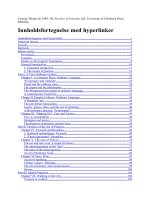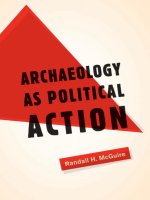university of oklahoma press finding sand creek history archeology and the 1864 massacre site sep 2004
Bạn đang xem bản rút gọn của tài liệu. Xem và tải ngay bản đầy đủ của tài liệu tại đây (2.71 MB, 268 trang )
Finding Sand Creek
Also by Jerome A. Greene
Slim Buttes, 1876: An Episode of the Great Sioux War (Norman,
1982)
Yellowstone Command: Colonel Nelson A. Miles and the Great
Sioux War, 1876–1877 (Lincoln, 1991)
(ed.) Battles and Skirmishes of the Great Sioux War, 1876–
1877: The Military View (Norman, 1993)
(ed.) Lakota and Cheyenne: Indian Views of the Great Sioux
War, 1876–1877 (Norman, 1994)
Morning Star Dawn: The Powder River Expedition and the
Northern Cheyennes, 1876 (Norman, 2003)
Washita: The U.S. Army and the Southern Cheyennes, 1867–
1869 (Norman, 2004)
Also by Douglas D. Scott
(with Richard A. Fox, Jr.) Archaeological Insights into the
Custer Battle: An Assessment of the 1984 Field Season
(Norman, 1987)
(with Richard A. Fox, Jr., Melissa A. Connor, and Dick Har-
mon) Archaeological Perspectives on the Battle of Little
Bighorn (Norman, 1989)
(with P. Willey and Melissa A. Connor) They Died with Custer:
Soldiers’ Bones from the Battle of Little Bighorn (Norman,
1998)
Finding Sand Creek
History, Archeology, and the
1864 Massacre Site
Jerome A. Greene
and
Douglas D. Scott
Foreword by Christine Whitacre
University of Oklahoma Press : Norman
Library of Congress Cataloging-in-Publication Data
Greene, Jerome A.
Finding Sand Creek: history, archeology, and the 1864
massacre site / Jerome A. Greene and Douglas D. Scott;
foreword by Christine Whitacre.
p. cm.
Includes bibliographical references and index.
ISBN 0-8061-3623-5 (alk. paper)
1. Sand Creek Massacre, Colo., 1864. 2. Cheyenne
Indians—Antiquities. 3. Arapaho Indians—Antiquities.
4. Excavations (Archaeology)—Colorado—Sand Creek
Massacre National Historic Site. 5. Sand Creek Massacre
National Historic Site (Colo.)—History. 6. Sand Creek
Massacre National Historic Site (Colo.)—Antiquities.
I. Scott, Douglas D. II. Title.
E83.863.G74 2004
978.8004'97353—dc22
2004041286
The paper in this book meets the guidelines for permanence
and durability of the Committee on Production Guidelines for
Book Longevity of the Council on Library Resources, Inc.∞
Copyright © 2004 by the University of Oklahoma Press, Nor-
man, Publishing Division of the University. All rights
reserved. Manufactured in the U.S.A.
12345678910
To the memory of
Don G. Rickey, 1925–2000,
Historian of the American West
This page intentionally left blank
The site of that historic [Sand Creek] affair has not been marked.
If it were possible, we, as a nation, doubtless had rather the event
could be forgotten.
—Walter M. Camp,
Proceedings of the Annual Meeting and Dinner
of the Order of Indian Wars of the United States
Held January Seventeenth Nineteen Hundred and Twenty
This page intentionally left blank
Contents
List of Illustrations xi
List of Tables xiii
Foreword, by Christine Whitacre xv
Preface and Acknowledgments xxiii
Chapter 1. The Sand Creek Massacre 3
Chapter 2. Historical Documentation of the Location
and Extent of the Sand Creek Massacre Site 26
Chapter 3. Identifying the Sand Creek Massacre Site
through Archeological Reconnaissance 63
Chapter 4. Postarcheology Archival Conclusions
Regarding the Location of the
Sand Creek Massacre Site 99
Appendices
A. Archeological Artifact Description and Analysis 123
B. J. H. Haynes Cheyenne Depredation Claim 163
C. Cheyenne and Arapaho Annuity Requests,
Receipts, and Lists 165
D. Lists of Abandoned Goods Found in the Camps at
Pawnee Fork, Kansas (1867); Washita River,
Oklahoma (1868); and Summit Springs,
Colorado (1869) 177
E. List of Known Arms and Ammunition Used by the
Colorado Volunteer Cavalry 183
Notes 187
Bibliography 215
Index 235
x CONTENTS
Illustrations
Figures
1. Colonel John M. Chivington 10
2. Black Kettle and other chiefs, 1864 13
3. George Bent 34
4. Aerial photographs of Sand Creek, 1936–37 38
5. Metal detecting in the South Bend of Sand Creek, 1997 65
6. Michael McFaul explains geomorphological
core-drilling work 67
7. .58-caliber round-ball-bullet cache 75
8. Crushed and flattened tin cups from the village site 75
9. Table knives, spoons, and forks found in the village site 76
10. Fragments of small tin food graters 76
11. Top and base to a tin coffeepot or boiler 77
12. Fragments of 12-pounder spherical case shot 77
13. Iron arrowheads found in 1999 78
14. Indian tools from the village site 80
15. Hide-preparation tools recovered in 1999 81
16. Steven DeVore conducting geophysical
remote-sensing work 83
17. Civil War picket pin found in the South Bend, 1997 85
18. Fragment of trade silver found in the South Bend, 1997 85
19. Plains Indian village along a creek, ca. 1870–89 110
20. Cheyenne village showing the horseshoe arrangement
of lodges, ca. 1880–1910 111
21. Scattered placement of tipis in a Plains Indian village,
ca. 1880–1910 112
22. Small-arms ammunition found in the village site 125
23. 12-pounder spherical case shot with Bormann fuse 133
24. Cross-section of 12-pounder spherical case shot 134
25. Brass photograph preserver and fragment of brass dress
shoulder scale 138
26. Buttons recovered in 1999 141
27. Indian ornaments found in 1999 143
28. Tailor’s thimble and New York Militia button
recovered in 1999 144
29. Base of a Dutch oven found in the village site 148
30. Farrier’s hammer and ax found in the village site 153
Maps
1. Sand Creek vicinity 29
2. George Bent diagram of village and Sand Creek
Massacre site, 1905–14 (University of Colorado) 36
3. George Bent diagram of village and Sand Creek
Massacre site, 1905–14 (Oklahoma Historical Society) 37
4. Bent-Hyde regional map 1 42
5. Bent-Hyde regional map 2 43
6. Samuel W. Bonsall map, June 1868 44
7. Archivally projected site of the Sand Creek Massacre 49
8. Troop and Indian movements, November 29, 1864 57
9. Boundary of the Sand Creek Massacre site 61
10. Archivally projected site of massacre with archeological
overlay 100
11. Land plat of the massacre site, ca. 1938 107
12. Distribution of all 1864-era artifacts found along
Sand Creek 108
13. Possible lodge-arrangement configurations 114
xii ILLUSTRATIONS
Tables
1. Sand Creek Artifacts by Functional Category 79
2. Comparison of Known Firearms Types Used by the
Colorado Cavalry at Sand Creek to Recovered
Ordnance Artifacts 94
3. Multidisciplinary Team Approach 118
This page intentionally left blank
Foreword
The place was well known to all the Cheyennes and Arapahos
and they used it as a camping ground for many years.
George Bent, quoted in
Life of George Bent: Written from His Letters
L
ook in any direction and the view stretches out uninter-
rupted, as the old adage goes, as far as the eye can see. The
site of the Sand Creek Massacre, located in Kiowa County in
southeastern Colorado, is far from the mountains that conjure
up most popular images of the state. Gently rolling prairie
grassland, the landscape is closer to that of Kansas, which bor-
ders the county on the east. Kiowa County, with an average of
less than one person per square mile, is one of Colorado’s most
rural, undeveloped areas. And on a recent visit to the Sand Creek
Massacre site, I was again impressed, as I had been so many
times during the past few years, by how it was another of the
many ironies of Sand Creek that such a profoundly peaceful
place could have been the scene of such horror. Because within
this place, along a five-mile stretch of land along a creek filled
with more sand than water, one of the most brutal events in
western history took place. And even though the physical land-
scape is wide open, the mental one is soon overwhelmed, for
it becomes impossible not to imagine the sounds and scenes
of November 29, 1864—the images of horse-mounted soldiers
streaming in from several directions, of surprised and terrified
Cheyenne and Arapaho villagers desperately trying to save
themselves by digging shelters in the sand, and of mutilations
and deaths, and the sounds of gunshots, howitzer fire, and
screams.
Often during the two years that I was part of the National
Park Service (NPS) project team that helped locate the Sand
Creek Massacre site, I listened to the descendants of massacre
survivors speak of the voices they heard in this place. For
them, those voices were the only proof needed to confirm that
this area was, indeed, the site of the massacre. But the govern-
mental processes for national-historic-site establishment require
more-tangible, “scientific” evidence. So in 1998, through the
efforts of Senator Ben Nighthorse Campbell, Congress passed
the Sand Creek Massacre National Historic Site Study Act,
which directed the NPS to work with the Northern Cheyenne
Tribe, the Northern Arapaho Tribe, and the Southern Cheyenne
and Arapaho Tribes of Oklahoma, as well as the Colorado
Historical Society, to verify the location of the massacre. At
that time the site was a matter of great speculation. Many
believed it took place along a section of Sand Creek referred
to as the South Bend. But although archeologists had walked
across nearly every square foot of the inside corner of that
bend, they had not found the physical proof they sought,
leading some to think that the site was elsewhere. The discus-
sion was more than academic. The lack of consensus regarding
the massacre location hindered efforts to list the site on the
xvi
FOREWORD
National Register of Historic Places and to respond to repeated
requests by Cheyennes and Arapahos to establish a memorial
at the site.
That uncertainty came to an end in May 1999, when the
Sand Creek Massacre Project team completed its successful
search for the site. Following months of research, the project
team focused its archeological efforts on a number of areas
along Sand Creek. At one site within the South Bend the crews
found what they were seeking. One hundred and thirty five
years after the massacre, they pulled out of the soil the shat-
tered plates, utensils, hide scrapers, awls, and personal items
that once belonged to the Cheyennes and Arapahos who were
camped at Sand Creek, along with fragments of the weapons
used to attack and kill them.
Jerome A. Greene and Douglas D. Scott were integral to the
success of this effort. By the time they began work on the Sand
Creek project, Jerry and Doug, both of whom are NPS employ-
ees, had well-deserved reputations as experts in the field of the
Indian wars, as evidenced by their individual and collaborative
work at Little Bighorn, Washita, and elsewhere. As the pro-
ject’s lead historian, Jerry examined all known historical doc-
uments—maps, diaries, firsthand accounts by Indian and mil-
itary witnesses, and congressional investigative reports—that
could shed light on the massacre location. The project method-
ology also called for this research, as well as the oral histories
of Sand Creek descendants, to be completed prior to the field-
work so that the archeologists could focus on the sites most
likely to yield evidence of the event. I, among others, was ini-
tially surprised when Jerry’s primary recommendation was a
place approximately one mile north of the area that most peo-
ple believed to be the massacre site. But his reasoning would
prove to be correct. Just a few weeks afterward, an archeolog-
ical survey team under lead field archeologist Doug Scott
uncovered over four hundred massacre-related artifacts on the
site Jerry had pinpointed.
FOREWORD xvii
Simultaneous with Jerry’s efforts, Doug Scott also prepared
for the upcoming survey. He interviewed local artifact collec-
tors and, together with other team members, examined aerial
photographs, the earliest dating to the 1930s, for evidence of
historical trails leading to and from the massacre site. And,
upon Doug’s recommendation, the NPS conducted a geomor-
phological assessment of Sand Creek that identified, through
an analysis of soil samples, those specific landforms where
1864-era artifacts potentially could be recovered. Doug’s great-
est contributions, however, came in the field and his subse-
quent analysis of what was found. His report on the condition
and distribution of the artifacts and what they tell us about
what happened at Sand Creek stand at the heart of this volume.
Together with Jerry’s contributions and those of all the project-
team members, Doug’s work directly contributed to the suc-
cessful effort to authorize Sand Creek as a national historic site.
During the course of the Sand Creek project, many people
shared with us their hopes for the proposed national historic
site. Some saw it as a place of contemplation where people of all
backgrounds could come to learn from the past, to know more
about the Cheyennes and Arapahos who called this land home,
and to honor the victims. Many envisioned it as a healing place
that could promote cross-cultural understanding. But that
understanding is still more a hope than a certainty, and it must
be an ongoing process. Sand Creek is a landscape filled with so
much history, so much meaning, and so much pain that one
does not have to scratch too deeply beneath its surface to bring
forth powerful emotions. And even this book, an important
work of scholarship that presents in a very straightforward
manner the historical and archeological evidence that helped
lead to the long-term preservation of Sand Creek, is likely to
stir up such responses.
The Sand Creek project team was a complex, sometimes
uneasy alliance of tribal members, property owners, and govern-
ment employees. As the project’s team captain, I participated in
xviii
FOREWORD
numerous meetings at which the group seemed stressed to the
point of fracture. But ultimately, we would come together
because, fundamentally, we shared one common goal—to ver-
ify the location of the massacre so that Congress would have
the information it needed to protect and preserve this special
place for future generations. And as part of that effort, the group
worked extremely hard to achieve agreement upon the bound-
aries of the Sand Creek Massacre site as delivered to Congress
and as presented within this book. But although the project
team reached consensus on this, many members also made it
clear that they held differing beliefs as to where exactly within
those boundaries are the locations of some of the key events of
the Sand Creek Massacre, including the village site.
In this book Jerry and Doug, based on historical and arche-
ological evidence, identify the site of the Cheyenne and Ara-
paho village that was attacked by Colonel John Chivington’s
troops. While many will find that evidence compelling, it is
important to know that others do not, specifically Sand Creek
descendants who believe that it conflicts with oral histories and
traditional tribal knowledge. It also is important to understand
that the methodology for the Sand Creek project called for the
evaluation of four lines of evidence: historical documentation,
archeological survey, tribal oral histories, and traditional tribal
knowledge. As part of their many contributions to this project,
over thirty Cheyenne and Arapaho descendants of massacre
survivors shared stories that had been handed down through
the generations. Anyone wanting to read those oral histories
and learn more about the traditional tribal knowledge of the
site should refer to the final NPS report on this investigation,
Sand Creek Massacre Project, Site Location Study, as an addi-
tional reference on the subject. Future research, including addi-
tional archeological work, may resolve some of the differing
interpretations. But if the discussions surrounding these points
of view are fervent, they are only that way because Sand Creek
is so very important to so very many people. One of my many
FOREWORD xix
wishes for the Sand Creek Massacre National Historic Site is
that it will be a place where people can learn about all these
points of view, how such views are often shaped by cultural
differences, and how diverse cultures may have different inter-
pretations of what is evident and true. Rick Frost, who served
as the Sand Creek project manager, often commented that the
boundaries of the Sand Creek Massacre site are large enough
to accommodate more than one view of history.
My most recent visit to Sand Creek was on a cloudless,
hot August morning, and we were accompanying a group of
visitors who had never been there before. Among us was
rancher Bill Dawson, who recently sold a piece of Sand Creek
land that holds not only remains of the massacre but also rem-
nants of the line camp once used by his grandfather, a cowboy
during the days of the open range, when cattle replaced bison
on the land. Alexa Roberts, the NPS ethnographer who helped
Cheyenne and Arapaho descendants of Sand Creek record their
oral histories, and who is now the first site manager of the
Sand Creek Massacre National Historic Site, was with us too.
Also present was Rick Frost, associate director of public affairs
for the NPS Intermountain Region, who had overall responsi-
bility for the NPS project. We wished that Barbara Sutteer,
another key member of the Sand Creek project team who
served as its Indian liaison and who has since retired from the
NPS, was with us that day, as she had been on many other
occasions. As we walked to the area where many of the mas-
sacre artifacts had been uncovered, several of us commented
on how extraordinarily beautiful the site was that day and how
tall the grasses had grown now that the land was no longer
being grazed. We pointed out to the visitors the only spot of
high ground on the landscape, the bluff from which Chiving-
ton’s men first saw the village. We showed them the line of
trees that marks the otherwise barely discernible Sand Creek,
including the crucial bend of the creek that makes a ninety-
degree curve, with angles pointing north and east. And while
xx
FOREWORD
we stood enclosed within the angles of that bend and talked
about the grasses and the view and what progress was being
made on opening the site to the public, my thoughts also wan-
dered elsewhere. I thought about what a remarkable journey
we all had taken to come to this place, how meaningful Sand
Creek had become in all of our lives, and how very grateful I
was for the opportunity to have been part of this project.
But for none of us is the effort to protect, preserve, and
memorialize the Sand Creek site more important than it is for
the Cheyenne and Arapaho descendants of the massacre. I am
very fortunate for having been able to know and work with the
tribal members of the Sand Creek Massacre Project team: Joe
Big Medicine, Eugene Black Bear Jr., Laird Cometsevah, Edward
Starr Jr., and Edward White Skunk of the Southern Cheyenne
Tribe; William “Lee” Pedro and Alonzo Sankey of the South-
ern Arapaho Tribe; Anthony A. Addison Sr., William J. C’Hair,
Hubert N. Friday, Burton Hutchinson, Joseph Oldman, Ben S.
Ridgely, Eugene J. Ridgely Sr., Gail J. Ridgely, and Nelson P.
White Sr. of the Northern Arapaho Tribe; and Steve Brady, Luke
Brady, Otto Braided Hair, Conrad Fisher, Norma Gourneau,
Reginald Killsnight Sr., Lee Lonebear, Mildred Red Cherries,
Holda Roundstone, and Joe Walks Along of the Northern
Cheyenne Tribe. While our connection to Sand Creek is recent,
Sand Creek is always with them, as it will be for their descen-
dants. It is they who hear the voices.
Christine Whitacre
Historian, Intermountain Support Office
National Park Service
FOREWORD xxi
This page intentionally left blank
Preface and
Acknowledgments
T
his book is the product of many people’s time, interest,
and endeavor. It is a reflection of their contributions and
deep commitment to finding the site of the Sand Creek Mas-
sacre. For some, the journey to locate the site was intensely
personal and spiritual; for all, it was a meaningful experience
not soon to be forgotten. And in the end, it was the dedication
of all participants to the mission at hand that brought results.
The search for the Sand Creek Massacre site in 1998–99
was a multicultural as well as multidisciplinary effort. It
represented a coming together of not only members of the
Cheyenne and Arapaho peoples but also professionals from
several disciplines, including history, ethnography, geomor-
phology, remote imagery, and archeology. All brought valuable
perspectives and talents to the matter at hand, and the inter-
disciplinary contributions enabled the process to proceed
smoothly and with the maximum potential for success. While
most of the site-related effort involved archival investigation
and interpretation by historians and on-site archeological exam-
ination and interpretation by archeologists, the contributions
from other fields supported this work and were manifested time
and again throughout the project. The National Park Service
Sand Creek Massacre Project team consisted of National Park
Service staff, Colorado Historical Society staff, and represen-
tatives of the Southern Cheyenne and Arapaho Tribes of Okla-
homa, the Northern Cheyenne Tribe, and the Northern Ara-
paho Tribe. As part of the site-location process, Cheyenne and
Arapaho descendants of Sand Creek Massacre participants con-
tributed accounts that had been passed down through the gen-
erations. The National Park Service held public open houses,
encouraging local residents to come forward with information,
including possible evidence of the massacre that had been
found on their land. While historians researched maps, diaries,
reminiscences, and congressional reports for pertinent infor-
mation, historic aerial photographs, the earliest dating to the
1930s, were examined for evidence of historic trails leading to
and from the massacre site. Other efforts included a geomor-
phological assessment of Sand Creek that identified through
soil analysis those specific landforms where 1864-era artifacts
could potentially be recovered.
Certainly the multidisciplinary approach to solving his-
torical questions is not a new strategy and has been employed
successfully elsewhere. As a result of this enterprise, however,
the project team was able to conclusively identify the location
and extent of the Sand Creek Massacre. It must be pointed out,
however, that, while all team members acknowledge that the
massacre occurred within commonly agreed-upon boundaries,
some parties offered scenarios at variance with the National
Park Service’s interpretation of the historical documents and
archeological discoveries, as will be addressed herein. The
following narrative, based largely on the National Park Ser-
vice’s Sand Creek Massacre site location study, published
internally in 2000,
1
is intended to exemplify the value of the
xxiv
PREFACE AND ACKNOWLEDGMENTS









